|
Padua, a city of waters
and its inland waterway 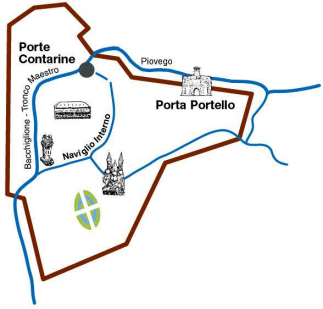 Inside its walls, Padua was crossed by a pleasant and very busy "Naviglio Interno" (inland waterways). All trade traffics entering the south of the town, from the Bassa Padovana area, Vicenza and the Euganean Hills, passed through the city, under its old bridges, along its winding Rivieras, crossed the Porte Contarine Lock, in the defending wall of the old town centre and passed into the Piovego canal to reach the Brenta river , Venice and the sea; navigating the Naviglio Interno upwards nobles and patricians reached their estates and castles in the Euganean Riviera. Althought the Naviglio Interno is no longer practicable (this due to the covering up in the ‘50), a suggestive cruise can still be made along the Piovego canal up to the surviving inner waterways of the town, coasting the renaissance walls, built by the Venetians after the attack of Massimiliano from Austria in 1509, when during the Cambrai War Padova was attacked and besieged by the imperial troops. The town was immediately freed, but the fear of other possible enemies led the Venetian Senate to provide a total re-make of the defending walls. Started in 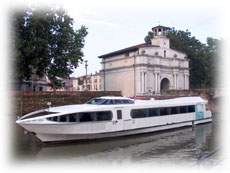 1513 under the rule of Bartolomeo D’Alviano, Captain of the Serenissima
Republic and was continued by Michele Sanmicheli and completed in 1544.
The defending system was pretty strong: 12 kilometres of walls and ramparts,
a marvellous example of military achitecture. According to the contemporaries
the town was inexpugnable.
1513 under the rule of Bartolomeo D’Alviano, Captain of the Serenissima
Republic and was continued by Michele Sanmicheli and completed in 1544.
The defending system was pretty strong: 12 kilometres of walls and ramparts,
a marvellous example of military achitecture. According to the contemporaries
the town was inexpugnable. From Portello Nuovo Bastion you reach the old river harbour of Porta Portello, also known as “Venezia Gate” or “Ognissanti Gate”. This used to be one of the most popular and cheerful areas of Padua, where boatmen, “cavallanti” and “beccai” met (they were famous for the fight with the students). 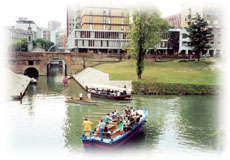 It was planned in 1518 by Guglielmo Grizi called the “bergamasco” (from Bergamo) and it was thought to have a representative meaning more then a military purpose. From the outside, made of a special stone from Istria, it reminds of a triumphal arch. It has eight columns and on top a small tower with a clock. Canaletto made a picture of Porta Portello with its beautiful sixteenth-century stairs. Beyond the bridge there is the Shrine of Santa Maria of the boatmen- 1790- where boatmen attended the Mass before boarding their barges. The flight of stairs was built in 1534 by the Podestà Pietro Lando and the Captain Marco Barbarigo. Paduans waited on the stairs to welcome the Venetian Provveditori and the important people visiting them. In the past, boats navigating rivers and canals linked Padua to its surroundings and to the Venetian lagoon. Continuing along the sixteenth-century Venetian walls, past the University campus, boats reach the former-slaughterhouse, a nine-teenth- century work by Giuseppe Jappelli and then, the Gardens of the Roman Arena with the famous Scrovegni Chapel painted by Giotto, and the Eremitani Church with works of Mantegna. | ||
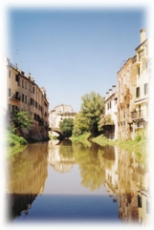 |
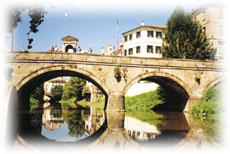 |
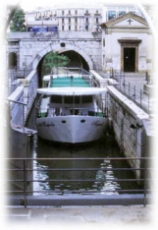 |
The noise of the water fades into that of the city traffic when it passed under the monumental Corso Bridge and reaches the Lock at Porte Contarine, in the old town centre. Once the fixed course for the fluvial traffic on the Naviglio Interno, the lock at Porte Contarine, inspired by Leonardo Da Vinci, was built by the Venetians in 1526 and was conceived for the control of the slope between the Piovego and the Naviglio Interno, thus allowing the boats coming from the Piovego to travel comfortably up and down the Naviglio Interno. The cruise continues up the Tronco Maestro of the Bacchiglione, among luxuriant vegetation, under a succession of bridges, among ancient and new palaces, to reach the old Molino Bridge and the medieval San Leonardo Bridge, the former entrance to the Jewish ghetto. Along the Tronco Maestro Riviera, passing by admirable old Palaces, it is possible to reach the San Benedetto Bridge, a wooden 1200 construction, completely rebuilt in iron after the liberty style in 1881. 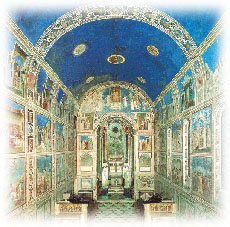 Further
along there is Dei Tadi Bridge, the most important one in the city in
medieval times, and San Giovanni delle Navi Bridge, where in the past
there was a small dock for the unloading of fruit and vegetables to be
sold at the market square. Along Riviera Paleocapa, the boat reaches the
old Sant’Agostino Bridge, near the Ezzelini
Castle, overlooked by its defensive tower first called Torlonga
and subsequently named Specola. The castle, built on the bifurcation of
two canals, overlooked all fluvial access to the town and was the most
important defensive point of the whole city system. Further
along there is Dei Tadi Bridge, the most important one in the city in
medieval times, and San Giovanni delle Navi Bridge, where in the past
there was a small dock for the unloading of fruit and vegetables to be
sold at the market square. Along Riviera Paleocapa, the boat reaches the
old Sant’Agostino Bridge, near the Ezzelini
Castle, overlooked by its defensive tower first called Torlonga
and subsequently named Specola. The castle, built on the bifurcation of
two canals, overlooked all fluvial access to the town and was the most
important defensive point of the whole city system.Here, at the convergence of the Bacchiglione’s Tronco Maestro (main branch) with the secondary branch of the Naviglio Interno, the magic cruise ends and it is possible to walk to the Castle and the Specola tower. |
||